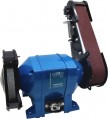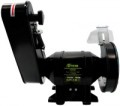Motor power
Rated power of the electric motor of the machine. The more powerful the engine, the higher the speed and intensity of processing can be, the larger discs can be used with the machine and the better it is suitable for working with hard, stubborn materials. On the other hand, a powerful motor consumes a lot of energy (which may require special connection — see "Power") and significantly affects the dimensions, weight and price of the entire unit. Therefore, manufacturers choose this parameter based on the type (see "Machine") and the desired characteristics of speed, productivity, etc. In fact, this means that engine power is rather a secondary parameter, and when choosing, it makes sense to pay attention to more practical points — disk diameter, rotation / movement speed, etc.
Disc thickness
The thickness of the "dry" blade (see "Dry Machining") for which the machine is designed. Usually, we are talking about the maximum thickness of the disc that can fit on the seat — most models allow the use of thinner nozzles.
Note that this parameter depends on the type of sharpening (see above): working with chains and saw blades involves a small thickness of the discs, universal sharpening is the opposite. And for grinding models, the thickness of the disc is not relevant at all, even if the disc is provided in the design; see "Machine" for details.
Disc speed
The nominal speed of rotation of the disk for dry processing (see above), provided by the machine; for models with adjustable rotation (see below), the maximum rotation speed.
For the same disc diameter and material, a higher speed provides more intensive processing, and a slower rotation contributes to accuracy and precision. In addition, optimal speeds depend on the composition of the disc and the material being processed; detailed recommendations with specific figures for a particular situation can be found in special sources.
A separate category is grinding machines with disk-shaped working elements: in such units, the actual speed of movement of the disk surface relative to the workpiece depends on how close the contact point is to the centre of the disk.
Belt length
The length of the belt used in a machine with grinding functions (see "Machine"), more precisely, the total length of the entire belt ring installed on the machine.
This information is necessary to select the correct sanding belts — matching in length is essential for the proper installation and operation of the attachment. In this case, the working length, usually, is more than 2 times less than the total, and to determine it, it is worth focus on the dimensions of the desktop (see below).
Belt width
Belt width for which the machine with grinding functions is designed (see "Machine"). The value of this parameter for compatibility with the tape can be different: in some models, the tape must exactly match the standard width, in others narrower tapes are allowed. From an application point of view, the larger width allows larger workpieces to be handled.

